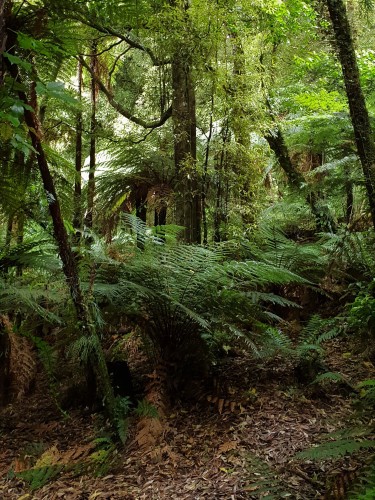Kahurangi likes men with beards, but seems to prefer them of a certain age – during our visit as she darted around her side of the fence the handsome hipster was largely ignored in preference for the more mature member of our party. It must be said that neither men were favoured with her famous wolf whistle, but we were all thrilled to hear her say the name of her species, the North Island “kōkako”.

How does she do it? I wondered how it is that without a human mouth, Kahurangi still manages to articulate similar sounds. It turns out that birds do have a larynx, but all (except vultures) also have a syrinx, at the base of their windpipe just above their lungs which is their ‘voice box’. We were intrigued to learn that scientists are searching for when the syrinx developed in birds as they evolved from dinosaurs.
Our classical music expert immediately recognised Syrinx as the name of one Debussy’s pieces for solo flute. The syrinx is named after the nymph in Greek mythology that Pan chased and who turned into a reed, which he then cut and played as pipes (and less poetically, this is also the origin of the word syringe).
As a songbird who has learnt the music of her group, Kahurangi’s vocabulary of wolf whistles and variations on ‘kōkako’ is a rather strange dialect (you can hear a recording in this interview). The call of the endangered wild kōkako in the bush is usually described as ‘haunting’, but to me many of the recordings are really quite similar to the sound of a squeaky door – perhaps you have to hear them in the bush for best effect. The fact that kōkako can mimic other bird songs means that it will probably be very hard for anyone to claim the recently announced $10,000 prize for re-discovery of the South Island kōkako by sound alone.

Since the success of breeding programmes around the country Kahurangi is the last kōkako in captivity, living at Pūkaha Mount Bruce National Wildlife Centre. She imprinted on the ranger who hand-reared her, which evidently explains her thing with beards. She certainly lives up to her name, meaning ‘blue’ and ‘precious’ (from ‘cloak of the sky’).
This cheerful little bird has got me wondering:
- Will anyone ever find the South Island kōkako?
- Can we save enough native bush for the kōkako to survive?
- Do birds lose their voices with syringitis?
- Will we some day find that once there were dinosaurs who sang like birds?

Very interesting. Pukekos sound quite primorial.
Sent from my iPhone
LikeLike